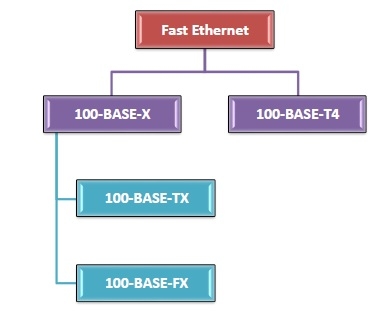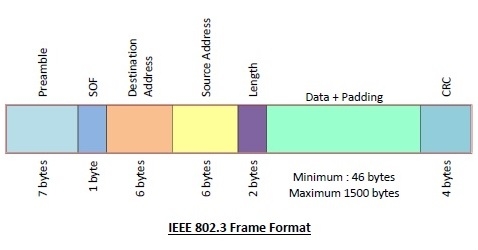
 Data Structure
Data Structure Networking
Networking RDBMS
RDBMS Operating System
Operating System Java
Java MS Excel
MS Excel iOS
iOS HTML
HTML CSS
CSS Android
Android Python
Python C Programming
C Programming C++
C++ C#
C# MongoDB
MongoDB MySQL
MySQL Javascript
Javascript PHP
PHPPhysics
Chemistry
Biology
Mathematics
English
Economics
Psychology
Social Studies
Fashion Studies
Legal Studies
- Selected Reading
- UPSC IAS Exams Notes
- Developer's Best Practices
- Questions and Answers
- Effective Resume Writing
- HR Interview Questions
- Computer Glossary
- Who is Who
Fast Ethernet (802.3u)
In computer networks, Fast Ethernet is a variation of Ethernet standards that carry data traffic at 100 Mbps (Mega bits per second) in local area networks (LAN). It was launched as the IEEE 802.3u standard in 1995, and stayed the fastest network till the introduction of Gigabit Ethernet.
Fast Ethernet is popularly named as 100-BASE-X. Here, 100 is the maximum throughput, i.e. 100 Mbps, BASE denoted use of baseband transmission, and X is the type of medium used, which is TX or FX.
Varieties of Fast Ethernet
The common varieties of fast Ethernet are 100-Base-TX, 100-BASE-FX and 100-Base-T4.

100-Base-T4
This has four pairs of UTP of Category 3, two of which are bi-directional and the other two are unidirectional.
In each direction, three pairs can be used simultaneously for data transmission.
Each twisted pair is capable of transmitting a maximum of 25Mbaud data. Thus the three pairs can handle a maximum of 75Mbaud data.
It uses the encoding scheme 8B/6T (eight binary/six ternary).
100-Base-TX
This has either two pairs of unshielded twisted pairs (UTP) category 5 wires or two shielded twisted pairs (STP) type 1 wires. One pair transmits frames from hub to the device and the other from device to hub.
Maximum distance between hub and station is 100m.
It has a data rate of 125 Mbps.
It uses MLT-3 encoding scheme along with 4B/5B block coding.
100-BASE-FX
This has two pairs of optical fibers. One pair transmits frames from hub to the device and the other from device to hub.
Maximum distance between hub and station is 2000m.
It has a data rate of 125 Mbps.
It uses NRZ-I encoding scheme along with 4B/5B block coding.
Frame Format of IEEE 802.3
The frame format of IEEE 802.3u is same as IEEE 802.3. The fields in the frame are:
Preamble − It is a 7 bytes starting field that provides alert and timing pulse for transmission.
Start of Frame Delimiter (SOF) − It is a 1 byte field that contains an alternating pattern of ones and zeros ending with two ones.
Destination Address − It is a 6 byte field containing physical address of destination stations.
Source Address − It is a 6 byte field containing the physical address of the sending station.
Length − It a 2 bytes field that stores the number of bytes in the data field.
Data − This is a variable sized field carries the data from the upper layers. The maximum size of data field is 1500 bytes.
Padding − This is added to the data to bring its length to the minimum requirement of 46 bytes.
CRC − CRC stands for cyclic redundancy check. It contains the error detection information.


